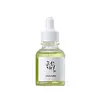What's inside
What's inside
 Key Ingredients
Key Ingredients

 Benefits
Benefits

 Concerns
Concerns

No concerns
 Ingredients Side-by-side
Ingredients Side-by-side

Camellia Sinensis Leaf Water
MaskingWater
Skin ConditioningPanthenol
Skin ConditioningGlycerin
HumectantButylene Glycol
Humectant1,2-Hexanediol
Skin ConditioningMethylpropanediol
SolventAcrylates/C10-30 Alkyl Acrylate Crosspolymer
Emulsion StabilisingTromethamine
BufferingBetaine
HumectantEthylhexylglycerin
Skin ConditioningAllantoin
Skin ConditioningDipotassium Glycyrrhizate
HumectantArtemisia Capillaris Extract
Glyceryl Acrylate/Acrylic Acid Copolymer
HumectantMelia Azadirachta Leaf Extract
Skin ConditioningPolyquaternium-51
Skin ConditioningMalt Extract
Skin ProtectingMelia Azadirachta Flower Extract
Skin ConditioningCoptis Japonica Root Extract
Skin ConditioningSodium Hyaluronate
HumectantCamellia Sinensis Leaf Water, Water, Panthenol, Glycerin, Butylene Glycol, 1,2-Hexanediol, Methylpropanediol, Acrylates/C10-30 Alkyl Acrylate Crosspolymer, Tromethamine, Betaine, Ethylhexylglycerin, Allantoin, Dipotassium Glycyrrhizate, Artemisia Capillaris Extract, Glyceryl Acrylate/Acrylic Acid Copolymer, Melia Azadirachta Leaf Extract, Polyquaternium-51, Malt Extract, Melia Azadirachta Flower Extract, Coptis Japonica Root Extract, Sodium Hyaluronate
Water
Skin ConditioningPropanediol
SolventGlycerin
HumectantSalicylic Acid
MaskingSodium Polyacrylate
AbsorbentButylene Glycol
HumectantEugenia Uniflora Leaf Extract
AstringentLaminaria Digitata Extract
Skin ProtectingRosa Canina Fruit Extract
AstringentSyringa Vulgaris Extract
Skin ConditioningOpuntia Ficus-Indica Stem Extract
Skin ConditioningLeontopodium Alpinum Meristem Cell Culture
Skin ConditioningMarrubium Vulgare Meristem Cell Culture
Skin ProtectingLecithin
EmollientGalactoarabinan
Schizophyllan
HumectantMaltodextrin
AbsorbentCaprylyl Glycol
EmollientPhytic Acid
Trisodium Ethylenediamine Disuccinate
Inulin Lauryl Carbamate
Emulsion StabilisingAcacia Senegal Gum
MaskingXanthan Gum
EmulsifyingMannitol
HumectantSodium Citrate
BufferingHydroxyacetophenone
AntioxidantTrehalose
HumectantSodium Bisulfite
AntioxidantErgothioneine
AntioxidantPhenoxyethanol
PreservativeChlorphenesin
AntimicrobialBenzyl Alcohol
PerfumingPotassium Sorbate
PreservativeSodium Benzoate
MaskingWater, Propanediol, Glycerin, Salicylic Acid, Sodium Polyacrylate, Butylene Glycol, Eugenia Uniflora Leaf Extract, Laminaria Digitata Extract, Rosa Canina Fruit Extract, Syringa Vulgaris Extract, Opuntia Ficus-Indica Stem Extract, Leontopodium Alpinum Meristem Cell Culture, Marrubium Vulgare Meristem Cell Culture, Lecithin, Galactoarabinan, Schizophyllan, Maltodextrin, Caprylyl Glycol, Phytic Acid, Trisodium Ethylenediamine Disuccinate, Inulin Lauryl Carbamate, Acacia Senegal Gum, Xanthan Gum, Mannitol, Sodium Citrate, Hydroxyacetophenone, Trehalose, Sodium Bisulfite, Ergothioneine, Phenoxyethanol, Chlorphenesin, Benzyl Alcohol, Potassium Sorbate, Sodium Benzoate
 Reviews
Reviews

Ingredients Explained
These ingredients are found in both products.
Ingredients higher up in an ingredient list are typically present in a larger amount.
Butylene Glycol (or BG) is used within cosmetic products for a few different reasons:
Overall, Butylene Glycol is a safe and well-rounded ingredient that works well with other ingredients.
Though this ingredient works well with most skin types, some people with sensitive skin may experience a reaction such as allergic rashes, closed comedones, or itchiness.
Learn more about Butylene GlycolGlycerin is already naturally found in your skin. It helps moisturize and protect your skin.
A study from 2016 found glycerin to be more effective as a humectant than AHAs and hyaluronic acid.
As a humectant, it helps the skin stay hydrated by pulling moisture to your skin. The low molecular weight of glycerin allows it to pull moisture into the deeper layers of your skin.
Hydrated skin improves your skin barrier; Your skin barrier helps protect against irritants and bacteria.
Glycerin has also been found to have antimicrobial and antiviral properties. Due to these properties, glycerin is often used in wound and burn treatments.
In cosmetics, glycerin is usually derived from plants such as soybean or palm. However, it can also be sourced from animals, such as tallow or animal fat.
This ingredient is organic, colorless, odorless, and non-toxic.
Glycerin is the name for this ingredient in American English. British English uses Glycerol/Glycerine.
Learn more about GlycerinWater. It's the most common cosmetic ingredient of all. You'll usually see it at the top of ingredient lists, meaning that it makes up the largest part of the product.
So why is it so popular? Water most often acts as a solvent - this means that it helps dissolve other ingredients into the formulation.
You'll also recognize water as that liquid we all need to stay alive. If you see this, drink a glass of water. Stay hydrated!
Learn more about Water